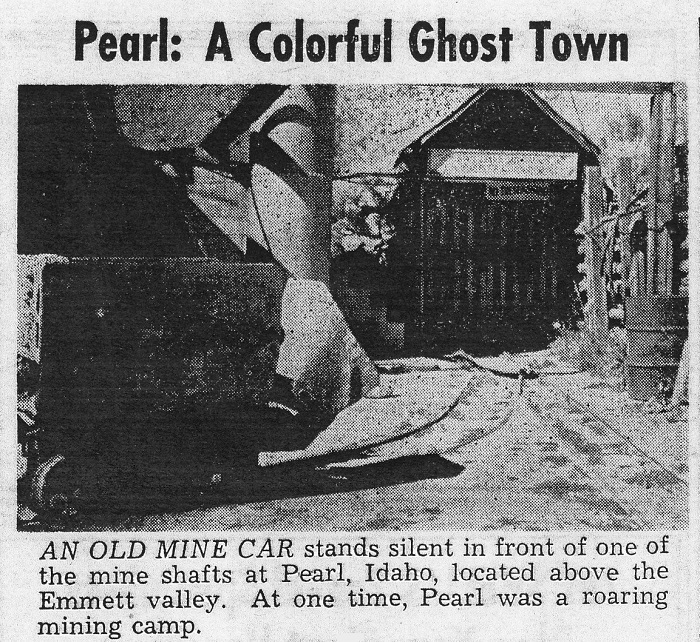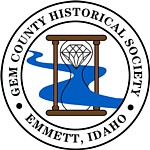Pearl: A Colorful Ghost Town
Messenger-Index, June 18, 1959

I've wrestled with rocks
and streams for mine
And made my friendships
with fir and pine.
Now the world down there
may think me odd,
But maybe I won't be queer to God.
—Edgar A. Guest
Pearl stands silent, nestled in between two hills 2,000 feet above the Emmett valley. Its deserted streets are a far cry from the booming and bustling gold camp that existed there over 50 years ago.
A Sunday traveler paying a visit to the ghost town finds it hard to believe that at one time 1,200 people made their home there. But in 1901-1903, the camp was a bee hive of activity with the populous at its peak.
Hundreds of buildings were erected on both sides of Willow creek. There were four saloons, several general merchandise stores, a boarding house, barber shop, butcher and slaughter house.
As the gold fever struck, more and more claims were filed by prospectors. The first one that old timers recall was made by the Caldwells in 1893. As time passed, such names as Maid of the Mist, Honolula, Highland Mary, and Three Links were spoken about the town.
Miners began to bring out the gold, silver, lead, and zinc from under ground. The ore was loaded and shipped to Salt Lake City for processing and smelting.
Back in those days, Pearl was part of Boise county. However, when Gem county was formed in 1915, the old mining camp was brought into its boundary lines. Pearl Lodge No. 70 of the International Order of Odd-fellows was organized. A fire department with a horse drawn wagon was formed. And many of the men spent their earnings at the saloons playing at cards or drinking hard liquor.
Meanwhile more mining claims were filed. Names such as Checkmate, Joan of Arc, Boer, Elk, Dixie, and Mikado were tossed around in bar conversations.
Along with the influx of white men came about 50 Chinese, who were noted for their cheap labor. At nearby Lincoln mine, 200 men were digging out the rich ore.
Many children were raised to adulthood in the camp. The late C. C. Anderson's wife was the daughter of C. C. Walters, a Pearl merchant.
Excitement wasn't void in Pearl. In 1906, the mill burned the ground.
Slowly the town died, as most mining camps do. The buildings began to disappear almost as fast as the people. Some old timers still claim "there's gold in those hills" if one could get a good price for the pay lode.
At the present time, about a dozen people are living in and prospecting the Pearl area. One of the larger mine there now is the Checkmate but it is not running. The last shipment out of Pearl from its veins was four years ago.
Curiosity seekers often make the trek to Pearl over a dusty 15-mile road that climbs to an elevation of 4,340 feet. Many are surprised to see what's left of what one old-timer called "quite a sporting town."
Copyright © 2013 - All Rights Reserved.
Unless otherwise attributed, all photos and text are the property of Gem County Historical Society
Serving Gem County since 1973.
Hours
Wednesday - Saturday 1:00pm - 5:00pm
& by appointment :: Extended hours during The Cherry Festival in June.
